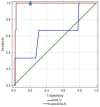Plasma Troponins Identify Patients with Very Low-Risk Acute Pulmonary Embolism
- PMID: 36835814
- PMCID: PMC9963057
- DOI: 10.3390/jcm12041276
Plasma Troponins Identify Patients with Very Low-Risk Acute Pulmonary Embolism
Abstract
Introduction: Although in the non-vitamin K oral anticoagulants (NOAC) era majority of low-risk acute pulmonary embolism (APE) patients can be treated at home, identifying those at very low risk of clinical deterioration may be challenging. We aimed to propose the risk stratification algorithm in sPESI 0 point APE patients, allowing them to select candidates for safe outpatient treatment.
Materials and methods: Post hoc analysis of a prospective study of 1151 normotensive patients with at least segmental APE. In the final analysis, we included 409 sPESI 0 point patients. Cardiac troponin assessment and echocardiographic examination were performed immediately after admission. Right ventricular dysfunction was defined as the right ventricle/left ventricle ratio (RV/LV) > 1.0. The clinical endpoint (CE) included APE-related mortality and/or rescue thrombolysis and/or immediate surgical embolectomy in patients with clinical deterioration.
Results: CE occurred in four patients who had higher serum troponin levels than subjects with a favorable clinical course (troponin/ULN: 7.8 (6.4-9.4) vs. 0.2 (0-1.36) p = 0.000). Receiver operating characteristic (ROC) analysis showed that the area under the curve for troponin in the prediction of CE was 0.908 (95% CI 0.831-0.984; p < 0.001). We defined the cut-off value of troponin at >1.7 ULN with 100% PPV for CE. In univariate and multivariate analysis, elevated serum troponin level was associated with an increased risk of CE, whereas RV/LV > 1.0 was not.
Conclusions: Solely clinical risk assessment in APE is insufficient, and patients with sPESI 0 points require further assessment based on myocardial damage biomarkers. Patients with troponin levels not exceeding 1.7 ULN constitute the group of "very low risk" with a good prognosis.
Keywords: echocardiography; pulmonary embolism; risk stratification; troponin.
Conflict of interest statement
The authors declare no conflict of interest.
Figures
References
-
- Miró Ò., Jiménez S., Mebazaa A., Freund Y., Burillo-Putze G., Martín A., Martín-Sánchez F.J., García-Lamberechts E.J., Alquézar-Arbé A., Jacob J., et al. Pulmonary embolism in patients with COVID-19: Incidence, risk factors, clinical characteristics, and outcome. Eur. Heart J. 2021;42:3127–3142. doi: 10.1093/eurheartj/ehab314. - DOI - PMC - PubMed
-
- Becattini C., Agnelli G. Predictors of mortality from pulmonary embolism and their influence on clinical management. Thromb. Haemost. 2008;100:747–751. - PubMed
LinkOut - more resources
Full Text Sources
Research Materials
Miscellaneous




